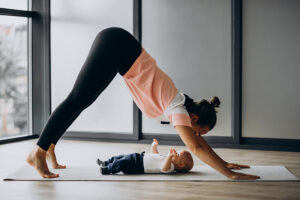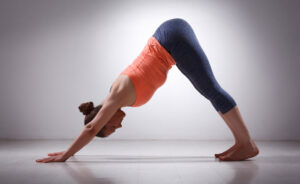Introduction: Embracing Serenity – Yoga’s Role in Easing Anxiety
Imagine a sanctuary where stress dissolves like mist under the morning sun, where each breath ushers in peace, and every movement weaves tranquility into the fabric of your being. This sanctuary isn’t a distant dreamland; it’s closer than you think, accessible through the ancient art of yoga. As you embark on this journey, discover how yoga isn’t just about twisting and turning; it’s a profound dialogue between your body and mind, a proven ally in the battle against anxiety.
Yoga: An Ancient Solution for a Modern Malaise
In our fast-paced world, where the buzz of anxiety is a constant background noise, yoga emerges as a beacon of relief. With roots stretching back centuries, yoga has evolved into a modern-day antidote to stress. Yoga’s ability to reduce anxiety is backed by research. For example, a study published in the National Institute of Health found that yoga significantly reduced symptoms of anxiety and stress in patients with anxiety disorders. Experts believe this is due to yoga’s ability to calm the mind, bringing a sense of balance and peace.
Gentle Poses, Profound Impact
Yoga isn’t about forcing your body into pretzel-like shapes; it’s about gentle, beginner-friendly poses that invite calmness into your life. Each posture, each breath, is a step away from anxiety and towards a tranquil state of being. As you move, stretch, and breathe, you’re not just shaping your body; you’re sculpting a more serene mind.
The Mind-Body Symphony
Imagine your body and mind as musicians in an orchestra, each playing a vital part in the symphony of your well-being. Yoga is the conductor, harmonizing this ensemble, balancing the physical with the psychological, the tangible with the intangible. Experts in mental health endorse yoga for its ability to synchronize the mind and body, creating a rhythm of calmness that echoes through every aspect of life.For a deeper dive into the science behind how yoga impacts the nervous system, check out this article from Harvard Medical School on yoga and the nervous system.
Your Journey Begins Here
As we embark on this exploration of yoga and its role in anxiety relief, remember that you’re not just reading words on a page; you’re taking the first step on a transformative path. A journey that promises not just fleeting moments of calm, but a lasting sanctuary of peace within you. So, breathe deep, open your heart, and prepare to unfold the gentle power of yoga in your life. Are you ready to turn the page and embrace a more tranquil tomorrow?
In the tranquil garden of yoga, certain poses are like soothing herbs, each with its own special way of calming the mind and easing anxiety. Whether you’re a beginner or have been practicing for a while, these five poses are your allies in the quest for peace. Let’s explore these poses, understand their benefits, and learn how to incorporate them into your daily routine.
1. Child’s Pose (Balasana)
How to do it:
– Start by kneeling on your yoga mat.
– Touch your big toes together, sit on your heels, then separate your knees about as wide as your hips.
– Exhale and lay your torso down between your thighs, forehead touching the floor.
– Stretch your arms forward, palms down.
Modifications: Place a cushion under your forehead or between your thighs and calves for added comfort.
Benefits: Often considered a pose of surrender, Child’s Pose helps release tension in the back, neck, and shoulders, areas where most people hold stress. It’s like a warm embrace, reminding you to take a moment to care for yourself.
2. Downward-Facing Dog (Adho Mukha Svanasana)
How to do it:
– Start on your hands and knees, with wrists aligned under your shoulders and knees under your hips.
– Exhale as you lift your knees off the floor, reaching your pelvis up toward the ceiling.
– Straighten your legs gradually, heels reaching towards the floor.
Modifications: If your hamstrings are tight, keep a slight bend in your knees. You can also place your hands on a raised surface like a block or a step.
Benefits: This pose rejuvenates the entire body by stretching the hamstrings, calves, and spine. It also increases blood flow to the brain, helping to relieve stress and mild depression.
3. Legs-Up-the-Wall (Viparita Karani)
How to do it:
– Sit with one side of your body against a wall.
– Gently turn to lie flat on your back and swing your legs up against the wall.
– Your body should form a 90-degree angle with your legs extended up the wall, and your back and head resting on the floor.
Modifications: Place a cushion or folded blanket under your lower back for extra support.
Benefits: This pose is a gentle inversion that allows for relaxation. It’s particularly good for calming the mind and can help relieve headaches and boost circulation.
4. Cat-Cow Pose (Marjaryasana-Bitilasana)
How to do it:
– Begin on your hands and knees, ensuring your knees are set directly below your hips and your wrists, elbows, and shoulders are in line and perpendicular to the floor.
– As you inhale, lift your sit bones and chest toward the ceiling, allowing your belly to sink toward the floor (Cow Pose).
– As you exhale, round your spine toward the ceiling, releasing the head toward the floor (Cat Pose).
Modifications: If your wrists are sensitive, try making fists or placing your forearms on the ground.
Benefits: This series of poses warms the body and brings flexibility to the spine. It also massages and stimulates organs in the belly, like the kidneys and adrenal glands, helping to relieve stress.
5. Supported Savasana
How to do it:
– Lie flat on your back, legs extended, arms at your sides, palms facing up.
– Use a bolster or blanket under your knees or lower back for support.
Modifications: If you’re uncomfortable lying on your back, try bending your knees with feet flat on the floor or a chair.
Benefits: Savasana is known as the ultimate pose of relaxation. It helps lower blood pressure, calm the nervous system, and promote deep rest.
Incorporating these poses into your daily routine can be a gentle yet powerful way to alleviate anxiety and stress. Remember, yoga is a personal journey; what matters most is how the practice feels in your body and mind. So, take it slow, listen to your body, and embrace the calming journey of yoga. Let each pose guide you closer to serenity, one breath at a time.
How Yoga Helps Combat Anxiety
In the serene world of yoga, each pose is more than just a physical exercise; it’s a key to unlocking a calmer, more centered self. But how exactly does yoga transform mental turmoil into tranquility? Let’s delve into the physiological and psychological mechanisms that make yoga an effective balm for anxiety.
The Mind-Body Connection: Harmony in Action
Yoga is not just a workout for the body; it’s a soothing melody for the mind. The ancient practice is rooted in the principle of the mind-body connection, acknowledging that emotional and mental health is deeply intertwined with our physical well-being. When you step onto the mat, you’re not just stretching your muscles; you’re also stretching away the day’s stresses, creating a harmony that resonates throughout your entire being.
Expert Insight: Dr. Pramod Choudhary PhD Vedic Yoga, a renowned yoga therapist from India, explains, “Yoga is a dance of movement and stillness, bringing balance to the nervous system and fostering a state of relaxation.”
Taming the Stress Response: The Role of the Nervous System
At the heart of yoga’s anxiety-relieving power is its ability to tame the body’s stress response. When we’re anxious, our sympathetic nervous system kicks into high gear, preparing us for ‘fight or flight.’ This response is useful in dangerous situations but can be harmful when triggered too often by daily stresses. Yoga acts like a gentle whisper, calming this response and activating the parasympathetic nervous system, also known as the ‘rest and digest’ system.
Studies have shown that regular yoga practice can decrease the secretion of cortisol, the stress hormone, helping to soothe feelings of anxiety and creating a sense of calm.
Psychological Benefits: A Journey to Self-awareness
Yoga is also a journey inward, offering a space for self-reflection and increased self-awareness. As you move and breathe, you become more attuned to your body’s signals and emotions. This heightened awareness can lead to better recognition and management of anxiety triggers. It’s like having a conversation with yourself, where each pose helps you understand and care for your mental state.Psychologist Kelly McGonigal, author of The Joy of Movement, explains how yoga helps increase self-awareness and emotional regulation in this excerpt.
The Relaxation Response: Breathing Away Anxiety
Central to yoga is the practice of controlled breathing or pranayama, which is a powerful tool for triggering the body’s relaxation response. Deep, mindful breathing helps to slow down the heart rate and reduce blood pressure, ushering in a state of calm. It’s like each breath is a wave, washing away the anxiety and leaving behind a shore of tranquility.
Scientific Backing: Research has confirmed that pranayama can alter the brain’s neurochemical balance, reducing anxiety levels and enhancing mood.
A Call to Action: Embrace the Calm
Yoga offers a holistic approach to anxiety relief, addressing both the physical and psychological aspects of stress. By engaging in regular practice, you’re not just performing exercises; you’re participating in a therapeutic ritual that has stood the test of time. So, roll out your mat, take a deep breath, and step into the world of yoga. Your journey to a calmer, more centered self starts now.
Tips for Practicing Yoga for Anxiety
Embarking on a yoga journey specifically tailored to alleviate anxiety is like planting a garden of tranquility. Here are some guiding lights to help you nurture this garden, ensuring each practice brings you closer to serenity.
1. Set Realistic Expectations
Understand that yoga is a journey, not a destination. It’s not about perfect poses but finding peace and balance. Celebrate small victories, like feeling a little more relaxed after each session. Remember, even a few minutes of yoga can be beneficial, so don’t pressure yourself to master everything at once.
2. Find a Style That Resonates
Yoga comes in many forms, from the gentle flow of Hatha to the invigorating rhythms of Vinyasa. Explore different styles and see which one speaks to your soul. For anxiety relief, you might prefer slower, more meditative practices. Many studios and online platforms offer trial classes, so take advantage of these to find your fit. Not sure where to start? Here’s a guide to the different styles of yoga from nonprofit Yoga Alliance to help you find the right fit.
Tip: Look for classes labeled as ‘gentle’, ‘restorative’, or ‘for stress relief’ – these are often designed with anxiety relief in mind.
3. Focus on Breathwork
Pranayama, or controlled breathing, is the heart of yoga and a powerful tool for calming the mind. Incorporate simple breathing exercises like deep belly breathing or alternate nostril breathing into your routine. Remember, the breath is your anchor; when your mind wanders into anxious waters, use your breath to guide you back to calm.
4. Listen to Your Body
Tune into your body’s cues. If a pose feels uncomfortable, ease out of it. Yoga shouldn’t hurt. Use modifications to make poses more accessible. For example, if touching your toes is challenging, bend your knees or use a strap. Your yoga practice is a personal dialogue between you and your body, so keep the conversation gentle and respectful.
5. Seek Guidance, If Needed
Especially when you’re just starting, a certified yoga instructor experienced in anxiety management can be invaluable. They can suggest poses, offer modifications, and provide the support you need. Many studios and online platforms in India and globally feature qualified instructors. Do your research and find someone who understands the path you’re on.
Creating Your Sanctuary
As you integrate these tips into your practice, remember that your yoga mat is a sanctuary. It’s a space where you can shed your worries and embrace a moment of peace. Each time you step onto your mat, you’re taking a step toward a calmer, more centered you. So, breathe deep, embrace the journey, and let the transformative power of yoga unfold in your life. Your path to tranquility starts here.
Creating a Calmer Mind and Life with Yoga
In the tapestry of life, anxiety can be like a stubborn knot, hard to untie and often re-tightening under stress. But what if you could weave in strands of tranquility through regular yoga practice? Let’s explore how this ancient art can not only provide immediate relief but also cultivate a long-term sanctuary of peace within you. For those combining yoga with other holistic practices, psychiatrist Dr. Sood shares his integrative approach to managing anxiety in his book The Mayo Clinic Guide to Stress-Free Living.
Embracing Regular Practice: A Path to Peace
Just like the sun gently rises every morning, regular yoga practice illuminates your inner calm, day by day. It’s not about perfect poses or mastering complicated sequences; it’s about consistent, gentle efforts. Over time, these efforts can transform into a profound inner stillness, turning the whispers of anxiety into echoes of the past.
Personal Anecdote: A teacher from Delhi, shares her journey: “Yoga became my daily ritual, like brewing morning tea. At first, it was just another task, but soon, it turned into my sanctuary. I’ve learned to move with my breath, and in doing so, I’ve moved away from anxiety.”
Progress Over Perfection: Celebrating Every Step
In the world of yoga, every pose is a poem, and every movement is a verse. There’s no rush to the finish line because the journey itself is where the magic happens. Celebrate the small victories, the moments of stillness, the breaths that bring peace. Remember, in the garden of well-being, every little seed of effort blooms into something beautiful.
Long-Term Benefits: Beyond the Mat
Yoga isn’t just an exercise; it’s a way of living. Its principles of mindfulness and balance can seep into every aspect of your life, from the way you handle stress at work to the way you interact with loved ones. It encourages a lifestyle that values harmony and self-care, paving the way for long-lasting mental and physical health.
Expert Insight: A well known psychologist specializing in stress management, notes, “Yoga is more than physical; it’s a mental practice. It teaches you to be present, and in that presence, you find peace. It’s a powerful tool for managing anxiety and enhancing overall well-being.”
Additional Resources: Expanding Your Toolkit
While yoga is a powerful tool, it’s part of a larger toolkit for anxiety management. Consider exploring additional resources like mindfulness meditation, guided relaxation, or even journaling. Many find that combining these practices with yoga creates a holistic approach to well-being.
Unfold Your Journey
As you stand at the threshold of this path, know that every breath, every pose, and every moment of stillness is a step toward a calmer, more centered you. Embrace yoga not just as a practice but as a companion in your journey to tranquility. Start small, stay consistent, and watch as the landscape of your mind transforms from turbulent seas to a serene lake. Your journey to a calmer life with yoga starts now. Are you ready to take the first step?
Conclusion: Your Gentle Warrior Journey Begins
As we come to the end of our journey through the world of yoga and its profound impact on anxiety, let’s take a moment to gather the threads of wisdom we’ve woven together. You’ve explored how yoga serves not just as a physical practice but as a gentle warrior in your fight against anxiety, offering a path to tranquility that extends far beyond the mat.
Summarizing the Path to Peace
Yoga is more than a series of poses; it’s a journey of self-discovery and inner peace. You’ve learned about the importance of regular practice, the power of breathwork, and the significance of listening to your body. We’ve unfolded how yoga not only alleviates immediate anxiety but also cultivates a long-term sanctuary of calm in your life.
Embrace Your Inner Warrior
Now, as you stand at the precipice of this path, remember that you are the gentle warrior of your own life. Each pose, each breath, is an act of courage, a step towards reclaiming your peace. Embrace the journey with patience and compassion, knowing that progress, not perfection, is your goal.
FlexifyMe: Your Ally in the Journey
If you’re seeking a guide on this path, consider FlexifyMe as your companion. With personalized exercise programs, expert guidance from certified trainers, and real-time posture correction through AI technology, FlexifyMe is here to support your journey towards a calmer mind and life.
“Ready to take control of your journey with chronic pain? FlexifyMe offers personalized exercise programs, expert guidance, and real-time posture correction through AI technology. Learn more and start a free trial today!”
The First Step Is Yours to Take
As you close this chapter, remember that the journey of a thousand miles begins with a single step. Whether it’s unrolling your yoga mat for the first time or deepening an existing practice, each movement is a declaration of your commitment to peace. So take that step, embrace the journey, and let your gentle warrior spirit lead you to a life of tranquility and well-being. Your journey begins now, and the path is yours to shape.
Ready to begin your yoga journey? Check out these yoga videos for beginners to start practicing at home.


